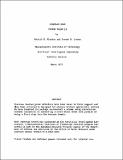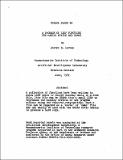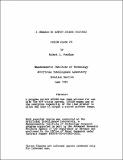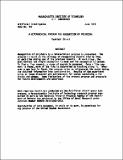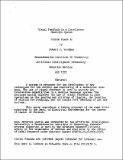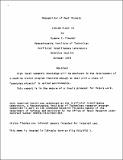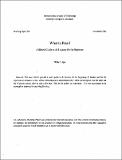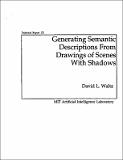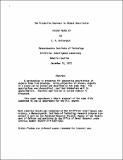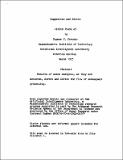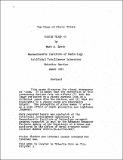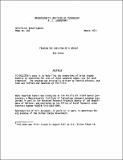Browsing AI Working Papers (1971 - 1995) by Issue Date
Now showing items 21-40 of 291
-
Circular Scan
(MIT Artificial Intelligence Laboratory, 1972-03)Previous feature point detectors have been local in their support and have been universally designed for objects without appreciable texture. We have invented (or perhaps reinvented) a scheme using correlation between ... -
A Package of LISP Functions for Making Movies and Demos
(MIT Artificial Intelligence Laboratory, 1972-06)A collection of functions have been written to allow LISP users to record display calls in a disk file. This file can be UREAD into a small LISP to reproduce the display effects of the program without doing the required ... -
A Program to Output Stored Pictures
(MIT Artificial Intelligence Laboratory, 1972-06)A program called LPTSEE has been written for use with the MIT vision system. LPTSEE makes use of the overprint capability of the line printer to allow the user to output a stored picture image. -
A Vision Potpourri
(MIT Artificial Intelligence Laboratory, 1972-06)This paper discusses some recent changes and additions to the vision system. Among the additions are the ability to use visual feedback when trying to acurately position an object and the ability to use the arm as a sensory ... -
A Stored Picture Hacking Facility
(MIT Artificial Intelligence Laboratory, 1972-06)A short description of LISP functions that have been written for use with the stored picture facility. These functions allow one to display an image of a stored scene on the 340 scope, and produce graphs and histograms of ... -
A Heterarchical Program for Recognition of Polyhedra
(MIT Artificial Intelligence Laboratory, 1972-06)Recognition of polyhedra by a heterarchical program is presented. The program is based on the strategy of recognizing objects step by step, at each time making use of the previous results. At each stage, the most obvious ... -
Using the Vidisector and the Store Picture Facility
(MIT Artificial Intelligence Laboratory, 1972-06)The stored picture facility (FAKETV) allows LISP users, and to some extent machine language users, to access a library of stored images rather than live vidisector scenes. The vidisector functions in LISP have been slightly ... -
Shedding Light on Shadows
(MIT Artificial Intelligence Laboratory, 1972-06)This paper describes methods which allow a program to analyze and interpret a variety of scenes made up of polyhedra with trihedral vertices. Scenes may contain shadows, accidental edge alignments, and some missing lines. ... -
Summary of Selected Vision Topics
(MIT Artificial Intelligence Laboratory, 1972-07)This is an introduction to some of the MIT AI vision work of the last few years. The topics discussed are 1) Waltz's work on line drawing semantics, 2) heterarchy, 3) the ancient learning business and 4) copying scenes. ... -
An Approach to Three-Dimensional Decomposition and Description of Polyhedra
(MIT Artificial Intelligence Laboratory, 1972-07)This paper presents a description methodology for trihedral planar solids that, as in Roberts' approach, decomposes an object into simpler components. The present approach, however, is more sophisticated and results in a ... -
Visual Feedback in a Coordinated Hand-Eye System
(MIT Artificial Intelligence Laboratory, 1972-08)A system is proposed for the development of new techniques for the control and monitoring of a mechanical arm-hand. The use of visual feedback is seen to provide new interactive capabilities in a machine hand-eye system. ... -
Recognition of Real Objects
(MIT Artificial Intelligence Laboratory, 1972-10)High level semantic knowledge will be employed in the development of a machine vision program flexible enough to deal with a class of "everyday objects" in varied environments. This report is in the nature of a thesis ... -
What to Read: A Biased Guide to AI Literacy for the Beginner
(MIT Artificial Intelligence Laboratory, 1972-11)This note tries to provide a quick guide to AI literacy for the beginning AI hacker and for the experienced AI hacker or two whose scholarship isn't what it should be. most will recognize it as the same old list of classic ... -
Generating Semantic Description from Drawings of Scenes with Shadows
(MIT Artificial Intelligence Laboratory, 1972-11)The research reported here concerns the principles used to automatically generate three-dimensional representations from line drawings of scenes. The computer programs involved look at scenes which consist of polyhedra and ... -
VISHEM: A bag of "robotics" formulae
(MIT Artificial Intelligence Laboratory, 1972-12)Here collected you will find a number of methods for solving certain kinds of "algebraic" problems found in vision and manipulation programs for our AMF arm and our TVC eye. They are collected here to avoid the need to ... -
The Projective Approach to Object Description
(MIT Artificial Intelligence Laboratory, 1972-12-15)A methodology is presented for generating descriptions of objects from line drawings. Using projection of planes, objects in a scene can be parsed and described at the same time. The descriptions are hierarchical, and lend ... -
Climber: A Vertex-Finder
(MIT Artificial Intelligence Laboratory, 1973-02)A LISP program has been written which returns the location of a vertex in a suspected region, as well as an indication of the certainty of success. -
Suggestions and Advice
(MIT Artificial Intelligence Laboratory, 1973-03)Results of scene analysis, as they are achieved, direct and advise the flow of subsequent processing. -
The Gloss of Glossy Things
(MIT Artificial Intelligence Laboratory, 1973-03)This paper discusses the visual phenomenon of gloss. It is shown that the perception of this phenomenon derives from two effects (1) that the image reflected by a glossy surface lies in a different plane from the surface, ... -
Finding the Skeleton of a Brick*
(MIT Artificial Intelligence Laboratory, 1973-03)TC-SKELETON's duty is to help find the dimensions of brick shaped objects by searching for sets of three complete edges, on for each dimension. The program was originally written by Patrick Winston, and then was refined ...

